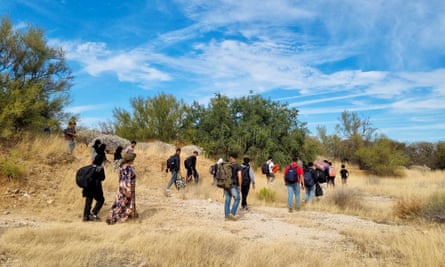When the Taliban stormed Kabul, Wali Modaqiq, 54, began calling every American, Briton and European with whom he had worked on environmental projects, pleading for help to evacuate him and his family.
“The message I received back was: ‘You’re not our direct employee, so we cannot help you,’” he said. “But I brought them in, I took them around, I helped them work in Afghanistan.” He says environmental activism with foreign conservationists had made him an enemy of the Taliban.
Working through back channels and every contact he had, Modaqiq and his family fled to Iran and then Turkey, where in March last year he caught a flight to an unlikely destination: Mexico City.
“I’m really grateful to the Mexican government because they gave us a safe passage letter,” Modaqiq said.
He assumed that Mexico would make for a quick, easy stopover before the family could head north as refugees. He wasn’t alone. Thousands of Afghans are believed to have made their way to Mexico since August 2021 in the hope of travelling on to claim asylum in the US.
On a mild, sunny Tuesday morning in Mexico City, Modaqiq sat in a classroom with four other Afghans practising Spanish, learning vocabulary that could help them get around the hectic city. Upstairs, a room full of Afghan women embroidered with Mexican volunteers.
This unassuming building in a calm residential neighbourhood has been turned into a community centre for people like Modaqiq by the International Rescue Committee (IRC).
“The needs of refugees from Afghanistan far exceed the [US evacuation] response that happened,” said Dan Berlin, director of the IRC’s Crossborder programme in Mexico. “There are tens, if not hundreds, of thousands whose protection needs were not met by the evacuation procedures that happened in the weeks following the Taliban takeover.”

The IRC launched the Mexico City community centre in September 2021 when the country’s government opened its doors to US media companies evacuating their Afghan staff. But after those 289 Afghans were all resettled in other countries, the centre remained open, amid an exponential growth of so-called “extra-continental migrants” from outside Latin America.
“It’s not just Afghans,” Berlin says. “We have Russian clients, Jamaican clients, Congolese clients, people from all over the world who mingle in the same space.”
Every day, between 30 and 50 people come through the centre for medical and psychological care, language classes and help with Mexican paperwork. The IRC distribute flyers in eight languages other than Spanish to migrant shelters across Mexico, hoping to reach migrants who feel particularly out of place.
In 2022, 17,450 migrants coming from Africa or Asia were detained by Mexico’s National Immigration Institute (INM), compared with just 3,852 in 2021. Last year, Mexico granted people from Africa and Asia 4,355 humanitarian visas, which allow them to temporarily reside in Mexico, compared with just 1,787 in 2021.
The growing number of Muslim migrants in Mexico is clearest in the border city of Tijuana, where in June 2022 the country’s first Muslim migrant shelter opened.
The IRC community centre has been a haven for people like Modaqiq and his family because they do not have the right to work or study in Mexico – and never expected they would be here for more than a year. Modaqiq filed his refugee application for the US 18 months ago.
He is one of hundreds of thousands of Afghans in limbo, still waiting to see if they will be allowed into the US as resettlement applications far exceeded US government expectations.
And being next door to the US has not helped Modaqiq like he thought it might.
Restrictions on asylum in the US mean smuggling his family over the US-Mexico border is a risky option: at least one Afghan asylum seeker has been criminally prosecuted for doing so.
He has tried US Customs and Border Protection’s CBP One, the heavily criticized mobile app which is the way people must now book an appointment to request asylum in the US. Like more than 100,000 other asylum seekers in Mexico, he wakes in the early hours of the morning to try his chances at one of 750 daily slots. He’s been unsuccessful since January.
“Somehow, all the doors are closed to Afghans,” Modaqiq said. “I don’t know why. I’m not saying it’s a bad thing but you see the Ukrainian crisis and all the doors and borders are opened to Ukrainians. That’s not the case for Afghans.”

Despite special resettlement programs in the US, Afghans in Mexico are among the masses of asylum seekers who are turned away from the US border, alongside those coming from countries like Honduras, Venezuela and Haiti. Since August 2021, 1,477 Afghans have been detained by the INM, which was responsible for the deaths of 40 Central and South Americans in a fire on 28 March.
As time wears on, Modaqiq feels more and more out of place in Mexico.
“I cannot keep my kids isolated from their religion, from their community, from their culture,” he said.
Even in the Mexico City megalopolis, there is a minuscule Muslim population and just one small mosque. Halal food is extremely hard to find. Modaqiq says his wife and daughters spend little time in public, uncomfortable with the strange glances they get for wearing hijabs and speaking Dari. He hopes they can connect with Afghan and Muslim communities in the US but he is starting to feel desperate.
When Modaqiq flew his family over the Atlantic Ocean and ended up just one border away from the dream of resettling in the US, he thought the hard part was over. He never considered that his refugee application could be denied, that he would still be waiting in Mexico more than a year later.
“I don’t have a backup plan,” he said.
